
The Forbidden City
In history the Chinese name for the ancient palace was Zijin Cheng meaning "Purple Forbidden City".
Snapshot:
On approach to the rustic fortifications of faded red defensive walls and tall gates the Forbidden City rises into view. The sensational Forbidden City has been listed by UNESCO as a world heritage site for its well-preserved ancient structures and is one of the largest palace centres in the world. Considered in ancient China, the emperor was mandated as the son of heaven, and consequently was bestowed with heaven's supreme power. Emperors from the Ming and Qing Dynasties administered their heavenly powers to reign, the Forbidden City became the Imperial power centre. What an ego!
Guarded by a 52-metre-wide moat and 9-metre-high red walls and arranged in grid pattern on a north to south axis within the 3,430-metre compound. The palace has an allocation of 999 buildings, halls pavilions and marble courtyards which accommodated the emperor, his family, servants, and concubines. The last Qing emperor to serve was defeated in 1911 by the republic. Officially called the Palace Museum, it became a public establishment in 1925 after Puyi, the last emperor.
Did you know: Many servants, maids and eunuchs lived their whole lives inside the forbidden City. No holidays for them! The Emperor was a tough boss.
Chinese legend declares number 9 represents longevity. The Forbidden City has 9999½ rooms. No wonder there were many servants to clean.
The Forbidden City was built this way to provide great protection from negative yin influences (opposite to Yang influences from Chinese Fengshui), like cold winds and travelling ghosts.
Modern Chinese call the Forbidden City - Ancient Palace.
The Meridian Gate
Entrance to the Forbidden City is through the magnificent 35 metre red Meridian Gate. Named Wufenglou, - Five Phoenix Tower. Proceed south through the Meridian Gate, and venture the huge expanse of courtyard across the five Golden Water Bridges to the outer court.
Facts:
- Bells and drums would sound when the emperor departed and arrived.
- The Gate has five entrances and five phoenixes decorate the ledges and bell towers.
- Once in a life time the Empress could only go through the middle gate on her wedding day. I bet the Empresses touched all the golden nails on the door.
- Located on the meridian line in Chinese culture.
Function of the Meridian gate:
- Significantly the emperor delivered the new lunar calendar and the winter solstice here.
- Armies were presented to the emperor for inspection.
- Ancient Chinese condemned officials were executed at the gate.
- Lanterns were hung at the gate for entertainment at 'lantern' festival.
Did you know: There are 81 doornails in nine rows and nine columns.
Tip - touch the golden nails in the red door for good luck.
Be ready for lots of walking and getting lost. No pluggers here however a walking stick is handy for seniors.
Outer court:
Three significant buildings influence the outer court, The Hall of Supreme Harmony, The Hall of Central Harmony, and The Hall of Preserving Harmony. The ceremonial halls are organized in groups of three. Three is represented by heaven. Upon entering the outer court, a three-tier marble terrace surrounds these three majestic Halls. In the courtyard in some of these prominant Halls, porticos display beautiful artefacts, caved jade ornaments, bronze sculptures, vases and artwork from the imperial ancient culture. Treasure!
Did you know: On rainy days 1,412 marble dragon heads below the columns of the three-tiered terrace, expel water becoming fountains. Dragons spit fire!
All the halls are built in accordance to the Yin and Yang theories.
Hall of Supreme Harmony
The Hall of Supreme harmony is the most significant structure in the palace. It is the largest wooden framework building in China and rises 30 metres above the courtyard. The hall was constructed in the 15th century and was the ceremonial centre. The Hall of Supreme Harmony is also known as the Hall of Golden Throne.
Facts:- Highest building in the Forbidden City and symbol of imperial power.
- Astonishingly foundations were in a thatched pattern of 15 layers, so intruders could not tunnel in and assassinate the Emperor.
- The roof is adorned with gold tiles and is supported by 72 pillars.
- Red window frames and doors are embossed with dragons and clouds.
- A sandalwood throne is positioned centre stage on a 2 metre platform, wrapped with five engraved dragons coiled around the hand rest.
- Emperor Exercised rule over the Chinese nation,
- Imperial meetings
- Facilitate enthronements
- Military nominations and dispatching generals into battles
- Grand ceremonies and Imperial weddings.
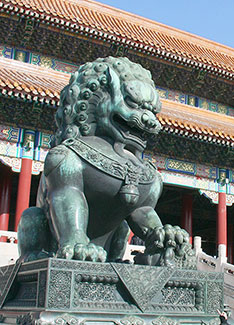
Did you know: In the emperor's presence the entire court touched the floor nine times with their foreheads, this custom was known as kowtowing.
Thresholds in the palaces were high to serve for weather protection. As you step over bend your head and make a bow, showing respect. Watch your step!
Two enormous gilded bronze vats stand at the entry and were filled with water in case of fire. In ancient China no fire engines were existing, so they must have used the bucket brigade
It was forbidden to grow trees here as they would dominate the Hall, only the emperor had supreme power.
Tip - Carry an umbrella for shade shelter from the sun.
Hall of Central Harmony
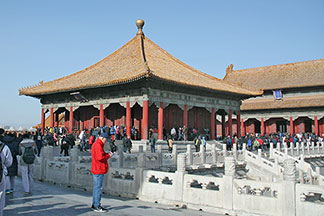
Along the outer court, between the Hall of Supreme Harmony and the Hall of Preserving Harmony, a single eave, golden roof square building with a prominent golden apex, appears from the paved concourse. The Hall of Central Harmony was first constructed 1420 during the Ming Dynasty and finally during the Qing reign the hall was called 'Zhonghedian' from the Doctrine of the 'Golden Mean' of Confucius. The belief was everything was to be done logically and everyone should be satisfied.
Facts:- Smallest of the three ancient halls
- Pavilion style architecture covering 580 sq. metres
- A golden throne and a pair of golden unicorns are seated next to the throne. They were seen to insight the emperor with wisdom and predict the future. Now that is intuition.
- Large bronze Incense burners were used to keep the emperor warm, no wonder the palace burnt down three times
- The hall suffered three fires and finally reconstructed in 1627
- The emperor rested here between transport to events
- Important speeches were devised
- last minute preparations for essential functions were organized
- Genealogy records were edited, and the emperor sealed their approval
- Each spring equinox the emperor checked agriculture tools and seeds at the hall.
Did you know: Ancient Chinese believed unicorns could travel 9,000 kilometers daily.
Yellow roof tiles were the exclusive colour of the emperor and symbolized his ultimate power.
The emperor's mode of transport about the Forbidden city was in a sedan chair. The emperor should have used the unicorns for quicker transport when he was in a hurry.
Hall of Preserving Harmony
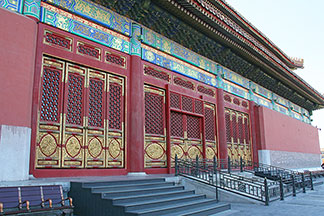
Last of the three impressive halls in the northern end of the outer court. The Hall of Preserving Harmony was built in 1420 and stands at the end of the magnificent three-tiered marble Terrance. Similar architectural building to hall of Supreme Harmony however smaller.
Facts:- Rectangular style wooden hall with double golden roof embellishing ten different animal statues on each corner Look up, Look up it might be a dragon.
- A breath-taking marble stairway is at the rear of the hall, centre sculpted and highlighting nine dragons playing with pearls. Spectacularly weighs 250 tons, 16.5-metre-long, 3.7-metre-wide, this single piece of ornate marble was dragged 70 kilometers to the site
- The Ming Emperor would change into ceremonial dress prior to formalities
- Banquets were bestowed to entertain high military officials at New Year's Eve and Lantern Festival by the Qing Emperors
- Princesses wedding parties held there
- Final imperial exam was designed and held by the emperor to qualify high officials
Did you know: Imperial palaces always had ten animal statues on the roof, this was a symbol of high rank.
Death was sentenced when the holy marble stone was touched.
Tip - Hands in pockets.
Inner Court:
The inner court is separated from the distinctive outer court by a courtyard. The Inner Court is designed using fengshui and is more intimate in design. The attractive buildings are smaller and still built with golden roofs and red walls, columns. The emperor and family conducted daily routines and the eunuchs and concubines dwelled here as well.
Palace of Heavenly Purity
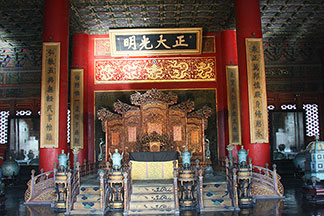
First and largest of the halls in the inner court is the most extravagant. Palace of Heavenly Purity built in 1420, a single white marble platform is the foundation for this impressive double eave building. The palace of Heavenly Purity – Qianqinggong stands for masculinity.
Facts:- Imperial throne is mounted on a dais, red candles, cloisonné burners and mirrors are surrounding the throne to ward off evil spirits.
- Above the throne hangs a plaque and behind it a small box storing the document decreeing who the next emperor will be.
- Largest palace in the inner court
- Bronze turtle and crane stand each side of the terrace entrance
- A sundial is outside the palace. SEIKO watches were not invented then.
- Emperors lived in this palace
- Affairs of government, signed documents, conducted ministerial interviews
- Auspicious banquets were held by the emperor
- Memorial ceremonies
Did you know: 16 emperors lived in the palace Two grand banquets were held for some 3000 senior men in the palace. This stood for the symbol of flourishing age. Now that is one large senior citizens party.
The emperors coffin was presented for days and later taken to the tomb.
In ancient time mirrors would make unseen spirits visible and reveal the future. Mirrors were often hung in burial chambers for this reason. Spooky!!!!!
Palace of Earthly Tranquility
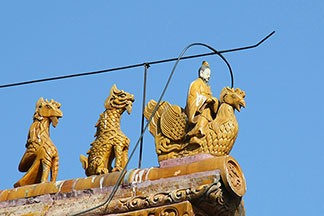
Positioned at the norther most end of the inner court the Palace of earthly Tranquility is constructed similarly to the Palace of Heavenly Purity. A double eave golden tiled roof palace with intriguing side buildings, stands 22 metres high. Originally built in 1420 for the Empress, it suffered two fires and rebuilt in 1596. The Palace of Earthly Tranquility – Kunninggong stands for femininity.
Facts:- Nine rooms and the front door is not in the middle of the hall it faces in an easterly direction.
- The bed chamber was painted red with 'double happiness' lanterns hanging from the ceiling.
- Carved with a dragon and phoenix, an exquisite bed canopy and quilt adorned the imperial bed, and both were embroidered with 100 vivacious children playing.
- The wedding chamber is still in the same decorative stat as Emperors Guangxu's reign.
- An altar in one western side room for worshipping deities and shaman.
- The palace served as a worship centre by Manchu rulers in the Qing Dynasty
- Nuptial chamber for the emperor and empress, the couple did not travel far of their honeymoon
- Important religious sacrifices in line with Manchu were offered twice a day
- Grand worship festivals were held here during Spring Festival, New Year's Day, and every lunar month
Did you know: By law The Emperor was bound to devote the first three nights of his marriage with the empress and the first day of Chinese New Year
The Emperor and Empress only stayed here for several days, short honeymoon.
Emperor Tongzhi's wedding cost 11,000,000 silver dollars, equal to 1.1 billion yuan.
Hall of Mental Cultivation
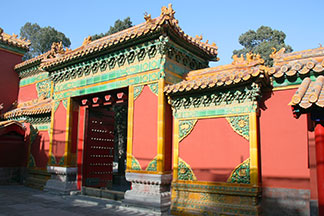
Positioned to the western side of the compound the Hall of Mental Cultivation structurally has many halls, secret rooms that were connected by hidden doors and screens.
Facing the superb entry gate, a magnificent carved jade screening wall with intricate dragons carved into the jade, a symbol of imperial power and high status. Two bronze lions with their paw on the world embellish the entry. The Hall of Mental Cultivation - Yangxindian symbols - just and benevolent.
Facts:- In ancient times the front gate was only opened to the emperor
- Behind the throne, bookcases holding scripts from earlier emperors with lessons on how to rule China
- The rear hall includes nine rooms, five centered rooms served as the emperor's bedroom, in two eastern rooms lived the empress and highly ranked concubines lived in the two western rooms.
- The infamous dowager Empress Cixi, lived in the eastern rooms and conducted her reign for 40 years from behind a silk screen
- 18th century onwards the Hall accommodated the Qing Dynasty emperors
- It was a great honor to become a eunuch. Hold on, remove what!
- Workshop to manufacture endless items for the imperial family
- Emperors sleeping accommodation
- The emperor handled routine work from the front hall Not far to the office.
- Meetings in private
Did you know: In ancient times the Hall of Mental cultivation was known as "Front Court and Rear Bedroom"
Legend declares a section of crystal was positioned in the courtyard to remind the empress to be honest.
The emperor would select a lucky concubine's name from a silver tray and eunuchs would carry her on their backs to the emperor in his bed chamber. Foot binding was a usual practice .
Palace of Gathered Elegance
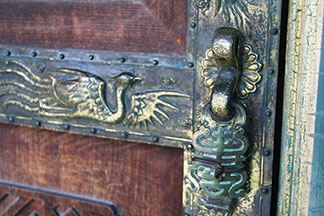
Located in the north east of the western palaces, the Palace of Gathered Elegance was originally built in 1420. The importance of Palace of Gathered Elegance is where the emperor's wife lived. An imposing throne carved from sandalwood and inlayed with ivory is impressive and the palace steps display ancient bronze deer and dragon statues.
Facts:- Empress Dowager Cixi gave birth to a son Zaichun in 1856 in the palace.
- Empress Dowager Cixi was granted the title Worthy Lady Lan.
- Empress Dowager Cixi spent 630,000 dollars of silver on refurbishments, this was where she realized her fortune. She won LOTTO!!!
- Roofed corridors in the courtyard are inscribed with special verses by her courtiers, for the empress's 50th birthday.
- 1910 Emperor Puyi installed a telephone exchange in the palace.
- Residence of ordinary concubines from the Ming emperors
- Emperor Guangxu selected his wives from this palace
- Storeroom for furniture after 1924
Did you know: Most of the palace of Gathering Elegance is displayed with its original furnishings.
It is the only palace with dragons in the eastern and western palaces, imperial rules states only dragons for the emperor.
The Imperial Garden
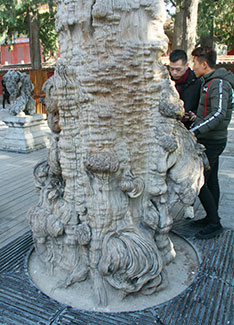
The most northerly point of the Forbidden City and designed in 1420. Rectangular in style the picturesque and captivating Imperial Garden covers 12,015 sq. meters, 80 metres long and 140 metres wide. I do not like weeding! There is a total of four gardens in the forbidden city – the Imperial Garden, Jianfu Garden, Garden of Benevolent Peace and the garden of the Palace of Peace and Longevity. Scattered among the micro gardens are exotic pavilions, unique stones, illusionary stone gardens, jade seats, golden unicorns, and bronze statues and incense burners.
Facts:- Abundant array of interesting patterns of landscapes, birds and Chinese characters designed in interlaced pathways
- Ancient landscapers used colourful pebbles in producing landscape designs
- ndulgent planting of ancient cypress trees, some over 100 years old
- Exotic flowers and rare herbs are grown
- A four-hundred-year Consort pine tree is still growing in front of the hall of Imperial Peace. Inspired by legend the pine denotes harmony to the ancient Chinese.
- Four dainty pavilions named after the four seasons of the year
- The beautiful ancient garden was built for the private retreat for quiet contemplation and reflection
- Imperial family admired stunning scenery, read, exercise.
- During important commemorations some pertinent activities were held in the imperial garden
- Emperor would pray and burn incense in the garden at the end of winter for a blessing from the Water God to avoid fire disasters
Did you know: The garden remains today in its original design
Over 160 ancient trees are dispersed throughout the garden
Legend says the Lianli Cypress tree is the symbol of love
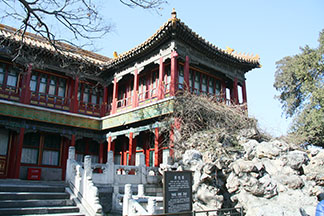
If feeling tired, pretend to be the emperor and rest on the jade garden seats and enjoy the scenery.
Wonderful place especially if the weather is sunny, bizarre rocks.
 Useful Information:
Useful Information:
Entrance Fee
| Entrance Ticket | April to October: CNY 60 November to March: CNY 40 |
| Treasure Gallery | CNY 10 (in Palace of Tranquil Longevity, including the Opera Museum and Stone Drum Museum) |
| Clock and Watch Gallery | CNY 10 (in Hall for Ancestry Worship) |
Opening Hours
| Months | Opening Hours | Ticketing Time | Entry Time |
| April to October | 8:30-17:00 | 8:30-16:00 | 8:30-16:10 |
| November to March | 8:30-16:30 | 8:30-15:30 | 8:30-15:40 |
It is closed on Mondays, except the Chinese statutory holidays and the summer vacation from Jul. 1 to Aug. 31.









